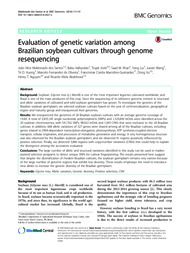Evaluation of genetic variation among Brazilian soybean cultivars through genome resequencing.
Evaluation of genetic variation among Brazilian soybean cultivars through genome resequencing.
Autoria: SANTOS, J. V. M. dos; VALLIYODAN, B.; JOSHI, T.; KHAN, S. M.; LIU, YANG.; WANG, J.; VUONG, T. D.; OLIVEIRA, M. F. de; MARCELINO-GUIMARÃES, F. C.; XU, D.; NGUYEN, H. T.; ABDELNOOR, R. V.
Resumo: Soybean [Glycine max (L.) Merrill] is one of the most important legumes cultivated worldwide, and Brazil is one of the main producers of this crop. Since the sequencing of its reference genome, interest in structural and allelic variations of cultivated and wild soybean germplasm has grown. To investigate the genetics of the Brazilian soybean germplasm, we selected soybean cultivars based on the year of commercialization, geographical region and maturity group and resequenced their genomes. We resequenced the genomes of 28 Brazilian soybean cultivars with an average genome coverage of 14.8X. A total of 5,835,185 single nucleotide polymorphisms (SNPs) and 1,329,844 InDels were identified across the 20 soybean chromosomes, with 541,762 SNPs, 98,922 InDels and 1,093 CNVs that were exclusive to the 28 Brazilian cultivars. In addition, 668 allelic variations of 327 genes were shared among all of the Brazilian cultivars, including genes related to DNA-dependent transcription-elongation, photosynthesis, ATP synthesis-coupled electron transport, cellular respiration, and precursors of metabolite generation and energy. A very homogeneous structure was also observed for the Brazilian soybean germplasm, and we observed 41 regions putatively influenced by positive selection. Finally, we detected 3,880 regions with copy-number variations (CNVs) that could help to explain the divergence among the accessions evaluated. The large number of allelic and structural variations identified in this study can be used in marker-assisted selection programs to detect unique SNPs for cultivar fingerprinting. The results presented here suggest that despite the diversification of modern Brazilian cultivars, the soybean germplasm remains very narrow because of the large number of genome regions that exhibit low diversity. These results emphasize the need to introduce new alleles to increase the genetic diversity of the Brazilian germplasm.
Ano de publicação: 2016
Tipo de publicação: Artigo de periódico
Unidade: Embrapa Soja
Palavras-chave: Cultivars, Genetic variation, Genoma, High-throughput nucleotide sequencing, Soja, Soybeans, Variação genética, Variedade
Observações
1 - Por padrão são exibidas publicações dos últimos 20 anos. Para encontrar publicações mais antigas, configure o filtro ano de publicação, colocando o ano a partir do qual você deseja encontrar publicações. O filtro está na coluna da esquerda na busca acima.
2 - Para ler algumas publicações da Embrapa (apenas as que estão em formato ePub), é necessário ter, no celular ou computador, um desses softwares gratuitos. Sistemas Android: Google Play Livros; IOS: iBooks; Windows e Linux: software Calibre.
Acesse outras publicações
Acesse a Base de Dados da Pesquisa Agropecuária (BDPA) para consultar o acervo completo das bibliotecas da Embrapa.

